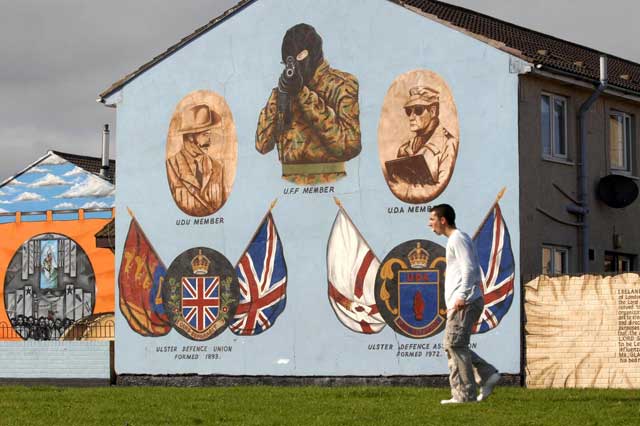A makeover for the murals that depicted hate, violence and bigotry

An important step in toning down the violent image of the Shankill Road is to be taken this week with the announcement of an agreement on the removal of some of its most ferocious murals. Ten of the district's most militant wall paintings are to be replaced as part of a project to replace portrayals of militarism with more pacific material relating to the area's cultural and industrial heritage.
The Shankill and other centres of paramilitarism have long been festooned with large paintings which often depict gunmen and other threatening images. During the Troubles, this warlike wall art became particularly associated with Northern Ireland, as both republicans and loyalists employed it to express defiance and territorial dominance.
The irony is that although many of the murals are designed to be off-putting and even threatening, they have, in recent years, helped attract large numbers of tourists to Belfast. During the summer, coaches and taxis carrying visitors regularly pause so tourists can be photographed in front of republican and loyalist murals.
But the authorities have been grappling for years with the question of how to get rid of such unwelcome reminders of violence. The aim is to reduce their number and reduce their general belligerence. To do so they have opted for a cautious process, stretching over a period of years to avoid provoking a backlash from the more militant backstreets elements.
The Shankill is regarded as one of the most problematic districts. It is bedecked with murals, many of which are sponsored by illegal paramilitary groups and feature sinister masked gunmen. They often commemorate and glorify militants who were killed.
The latest move, spearheaded by the city council, follows months of consultations involving community groups, residents, artists and local politiccians. More consultations, including a public meeting, will follow to identify themes for replacement murals in a process which includes the local Arts Council. Part of the strategy is to provide financial incentives and advice as part of a programme "to transform local communities by tackling the visible signs of sectarianism and racism by creating a more welcoming environment for everyone".
Loyalist paramilitary groups have not actively resisted losing some of the murals they sponsored, although they are adamant that not all will disappear. On the republican side, murals have evolved greatly, with a growing emphasis on comment on current events and international affairs: the Falls Road features a drawing critical of George Bush and the Iraq war.
But many depictions of dead IRA members persist, in particular those of the hunger striker Bobby Sands, which dominates the road. The Falls and surrounding districts contain more than 130 murals whose locations appear on a recently published map. Glen Phillips, a tourist officer, said: "The murals are recognised worldwide. Many tourists who visit west Belfast head straight for them."
A pilot scheme launched in Protestant east Belfast several years ago has proved successful. Although some images of gunmen remain, other murals depicting the Troubles have been replaced by paintings with local links, including the Titanic, George Best and C S Lewis.
One of the most popular shows the Northern Ireland footballer David Healy scoring the winning goal in a famous victory over England. Another depicts James Magennis, a Belfast Catholic, who was awarded the Victoria Cross in the Second World War. One of the scariest, which has now gone, featured a skeleton brandishing a knife, with the slogan: "Kill 'em all – let God sort 'em out."
Jim Wilson, a well-known east Belfast resident, explained: "The three main paramilitary groups agreed it would be a good idea to start changing a few of the particularly aggressive murals to lower tensions. All the old murals won't come down – there's going to be part of our history that will still be there. That legacy is not going to be whitewashed."
Outlining how the scheme took shape in east Belfast, the Rev Gary Mason, a Methodist minister said: "I've been in a dialogue with loyalist paramilitaries for several years, and nine of their murals have been replaced. Initially some people were reluctant but gradually they saw the light. They said paramilitary murals were part of their culture and a tribute to their dead comrades. We said, 'A better tribute to their dead comrades would be to get their kids jobs'.
"When you have these murals up, people are not going to invest in these areas because you're sending out the wrong signals. So we said, 'Let's continue to celebrate the culture but let's try to do it in a different way'."
Subscribe to Independent Premium to bookmark this article
Want to bookmark your favourite articles and stories to read or reference later? Start your Independent Premium subscription today.

Join our commenting forum
Join thought-provoking conversations, follow other Independent readers and see their replies